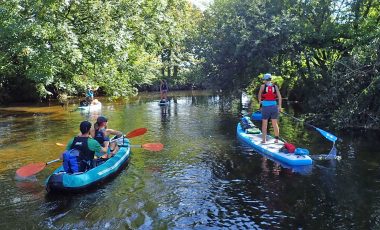Until the recent boom of paddle boarding, the kayak vs paddle board dispute wasn’t really a thing. Most paddlers argued over the virtues of canoes and kayaks, and paid little attention to these newcomers called paddle boards. But now, in 2022, I rarely head out on the river or to the beach without seeing way more paddle boarders than kayakers.
Yes, paddle boards are gaining popularity like nobody’s business. But before you go jumping on the stand up paddling bandwagon, it’s worth considering the paddle board vs kayak argument and exploring all your options. Doing this will make your decision much easier and ensure that you opt for the right floating vessel for your wants and needs.
- SUP vs kayak FAQs
- Paddle board vs kayak: what’s the difference?
- Paddle board vs kayak: things to consider
- Paddle board vs kayak: which is better?
- Paddle board vs kayak: the verdict
- Paddle board kayak hybrid
SUP vs kayak FAQs

Paddle board vs kayak: what’s the difference?
Before I get into the pros and cons of paddle boards vs kayaks, it’s important to clarify the difference, especially if you’ve never encountered either. Firstly, when you think of a kayak you may be picturing an open boat with high sides that is paddled on one side. This is actually a canoe, not a kayak. They’re easily muddled. For a run-down on the differences and pros and cons of canoes and kayaks, read our canoe vs kayak article.
Now that that’s cleared up, let’s get onto the difference between kayaks and paddle boards.
Stand up paddle board features
- Paddle boards are similar to surf boards in their shape.
- They have a flat deck that you stand on and there is no cockpit to sit inside.
- There is no internal space for storage – all cargo must be placed on top of the board.
- SUPs have flat bottoms that may curve out of the water slightly at the nose.
- You can get inflatable or hard paddle boards. Inflatables are most common for recreational paddling.
- SUPs are paddled with long, single blade paddles that are like canoe paddles, but longer.
Kayak features
- There are a few different types of kayaks. Some you can sit inside (these have closed cockpits), and some you can sit on top (these have open cockpits).
- Kayaks have side walls that create a space inside the hull of the boat to sit inside or on.
- You can store stuff both inside and on top of a kayak.
- Most kayaks are hard shells made of tough plastic. However, inflatable kayaks are becoming more and more popular.
- Kayak paddles have a paddle blade on each end of the paddle shaft.

Paddle board vs kayak: things to consider
So, we’re all clear on the difference between paddle boards and kayaks. The next thing to figure out is what’s important to you when deciding upon your vessel of choice.
Consider the following things:
Where and how will you be paddling?
If you are considering investing in a kayak or paddle board for the first time, or switching from one to the other, then it’s likely that you have an idea of where and how you envisage using the vessel. But to help you become clearer here are a few things to consider:
Playing around at the beach
Sit on kayaks and paddle boards are both ideal for family use where kids (and adults!) will spend as much time leaping into the water as they will paddling. Paddle boards, however, are much more portable to and from the beach and you can get multiple children on (and off) a single paddle board very easily.
River expeditions
Assuming you’re not taking on gnarly white water, both kayaks and paddle boards are ideal for long days on slow moving rivers. Paddle boards generally have a little more space to carry gear and food coolers on longer trips.
Whitewater river trips
Whitewater river trips should only be embarked upon with a guide or if you are experienced. They can be done on a specialist whitewater paddle board. However, kayaks are much more commonly used.
Exploring the coast
If the conditions are calm and you’re sticking close to the land, both kayaks and paddle boards are ideal for exploring the coastline.
Open sea expeditions
Sea kayaks are best suited to this as they are long, fast to paddle and have a fully closed cockpit to store gear in. That said, there are touring paddle boards that are designed for use on the sea and can carry gear.
Weather and conditions
The main weather conditions to consider when it comes to performance is the wind. In general, paddle boards are much more affected by the wind than kayaks. The result of the wind can also cause the water to become choppy and unpredictable making balancing for paddle boarders an extra challenge. Therefore, if you will predominantly be paddling in windy and wild conditions, a paddle board may not be the best choice.
Conversely, SUPs are very well suited to hot and calm conditions. Unless you have a sit-on kayak, it’s easier to hop in and out of the water from a SUP.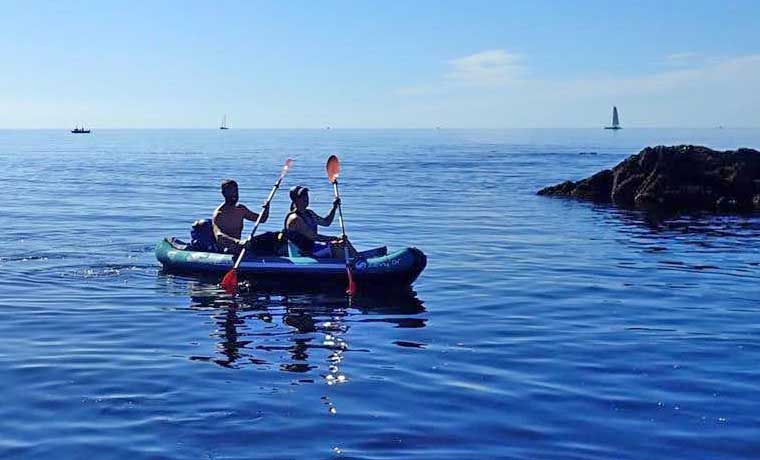
Ease of paddling
Most people find kayaking instantly easy. Yes, they may go round in circles a few times whilst they get to grips with how to paddle, but if they are in a stable, beginner-friendly kayak, they’ll be cruising in no time.
Paddle boarding isn’t quite so easy to pick up. It requires a degree of balance and confidence to not worry about falling in, and it can feel pretty wobbly for a little while. Additionally, efficient paddle technique can take a little time to get good at, and although paddle boarders tend not to go round in circles like beginner kayakers do, they do an awful lot of zig-zagging!
With practice, however, paddle boarding becomes much easier and as a result, more enjoyable.
Comfort
This is very much a personal thing. However, it’s also an important thing to consider. While some people would rather spend their day sitting back and relaxing as they float along in a kayak, some folk find being in the same position for ages pretty uncomfortable. Paddle boards are designed to be paddled standing up. But they can also be paddled kneeling up, kneeling back on your heels or even sitting. Plus, if you’re on a flat section of water you can even lie down and let the water carry you! The varied paddle positions offered by SUPs are highly appealing to those who lack flexibility or get uncomfortable sitting for long periods.
Ease of setup
Hard shell kayaks and paddle boards have zero setup time. You may have to adjust the seat and footrests slightly on a kayak, but that’s it.
Inflatable kayaks and paddle boards on the other hand, take around 10 minutes to inflate and attach fins etc. Of the two, paddle boards are generally a little quicker.

Gear storage options
If you intend on carrying lots of gear for overnight trips and paddling expeditions, you’ll need a vessel that has the capacity to store the gear. Sea kayaks and some hard shell kayaks offer water-tight storage hatches that are built into the boat. You can also fit dry bags inside the cockpits of most sit-in kayaks.
Most paddle boards and some kayaks have bungee cords on the top deck to attach gear to. The gear should be stored in waterproof dry bags.
At home storage
It’s essential that you have somewhere suitable to store your paddle board or kayak at home. Hard shell kayaks and paddle boards need lots of space, either inside a garage or shed, or in a secure place in your backyard.
Inflatable kayaks and paddle boards require much less space to store. A garage is ideal, however they can easily fit in a cupboard inside the house, if need be.
Transportation
As with storing your kayak or paddle board, your method of transportation is also key. Roof racks and a car are essential for hard-shell kayaks and paddle boards. Whereas inflatables can be carried in a backpack and easily chucked in the trunk of your car. Inflatables are a good option if you are hoping to transport multiple vessels (unless you have a huge truck!)
Versatility
Lastly, versatility is something to consider. You may already know that you only ever want to paddle on the sea in rough conditions, or that you’ll only ever likely go out on hot, sunny and calm days. However, if you’re not quite sure how, when and where you want to use your paddle board or kayak then opting for something versatile is a good place to start. Kayaks offer a little more versatility in terms of the types of water and conditions that they are suitable for paddling on and in.
Paddle board vs kayak: which is better?
The above section highlights some of the pros and cons of paddle boards and kayaks. However, there are a few points I’ve not covered. The below summary includes all of the pros and cons of both.

Paddle board pros and cons
Paddle board pros
- Standing up means you get a better view of your surroundings.
- You can vary your paddling position from standing to kneeling and sitting.
- Inflatable paddle boards can be easily carried to remote locations.
- You can store lots of stuff on top of touring paddle board.
- If you don’t fall in the water, you’ll stay more dry on a paddle board than in a kayak.
- You can lie down on a paddle board!
- Kids love playing on paddle boards.
- Paddle boards are very difficult to capsize.
- Paddling hard is a full body workout.
- You can burn more calories paddle boarding than kayaking (though this does depend on how hard you are paddling… floating doesn’t count!)
Paddle board cons
- They can be affected by the wind.
- It takes a bit of practice to become proficient at paddling a SUP.
- SUPs can be tough to paddle in choppy conditions.
- It’s easy to fall in the water when paddle boarding – especially as a beginner.
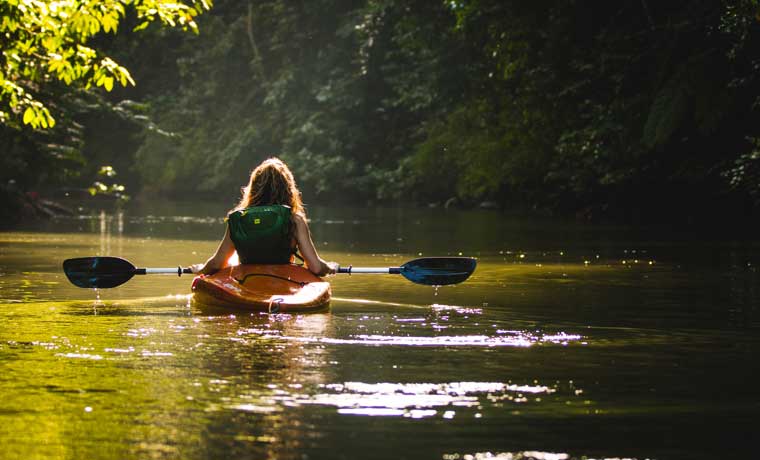
Kayak pros and cons
Kayak pros
- Kayaks are easier to paddle than SUPs in most conditions.
- Recreational kayaks tend to go faster than recreational paddle boards.
- Kayaks perform better in whitewater and in open seas.
- Kayaks are generally easier to manoeuvre than paddle boards.
- If you wear a spray skirt then your lower body should stay dry – in theory!
- Beginner paddlers tend to pick up kayaking much quicker than paddle boarding.
- Kayaks tend to be less effected by the wind than paddle boards, though this does depend on whether it’s an inflatable or not.
Kayak cons
- It’s relatively easy to capsize a kayak.
- If you capsize then you have to empty your boat before you get back in.
- If you don’t want to fall out when you capsize you’ll need to wear a spray skirt and be able to eskimo roll the kayak. This takes tuition and practise.
- Kayaks can become uncomfortable over long periods.
- Hard shell kayaks are cumbersome to carry, store and transport. Read our guide to portable kayaks for an alternative to a hard shell.
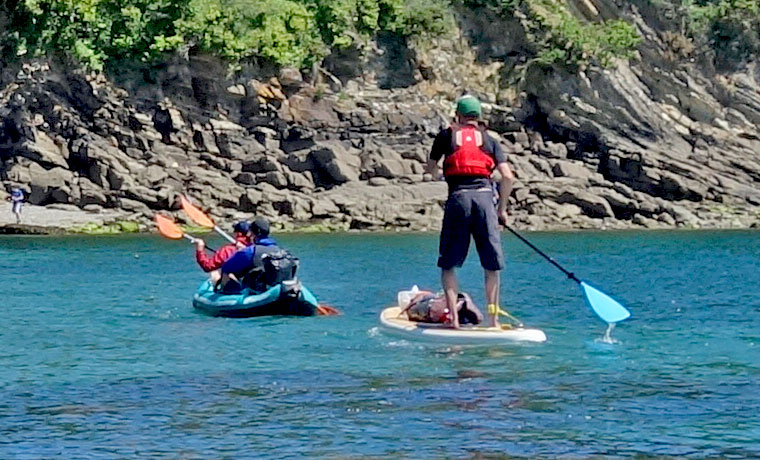
Paddle board vs kayak: the verdict
As you can see from the list of pros and cons for both kayaks and stand up paddle boards, it’s virtually impossible to give a definitive answer to this.
I’ve spent a lot of time in a kayak, both on rivers and the sea, and I’ve always had a great time. Recently, however, I’ve very much enjoyed paddle boarding. My board has a load of space for camping gear and I really enjoy paddling it on flat water. I also like that, because it’s an all rounder board, I can take it out on small waves. Additionally, I’ve always preferred paddling a canoe rather than a kayak. So I like how the SUP paddling action is similar to paddling a canoe.
Hopefully, with the above information and advice, plus your own ideas of what you think you want out of your time on the water, you now have a good idea of which is more suitable for you.
That said if you’re just starting out, and you’re really not sure which you’d prefer, then there is an option that might have all of your needs and wants covered: the paddle board kayak hybrid…
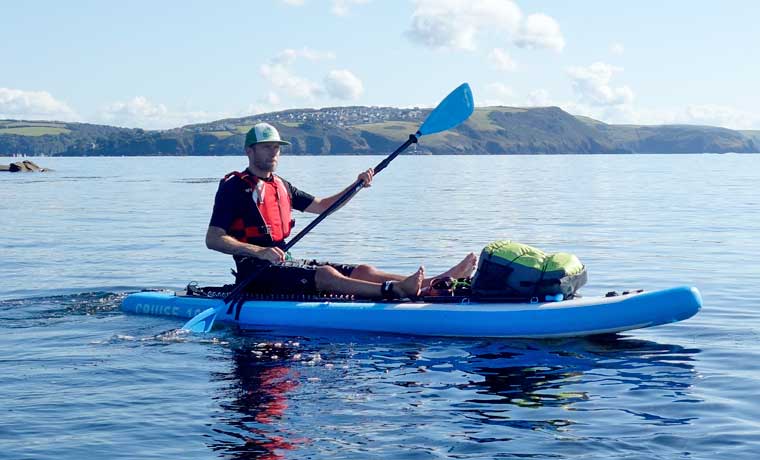
What is a paddle board kayak hybrid?
A fine question indeed! Well, simply put, a paddle board kayak hybrid is a paddle board with attachment points that allow you to rig up a kayak seat on the board deck. Paddle boards that come with this setup don’t look or perform any differently to regular paddle boards. They are, essentially, just a paddle board. The difference is that their package includes a kayak seat, a paddle that converts into a double kayak paddle, and attachment points to secure the seat in place.
The beauty of paddle board kayak hybrids is that you have yet another position you can paddle in. The ability to sit low on the board with a supported back and paddle with a kayak paddle, is a game-changer in windy conditions. I was recently out on an estuary on my SUP. The headwind really started to pick up and paddling was becoming tougher and tougher. I was mostly paddling on my knees to reduce the resistance against the wind. But I was fatiguing quickly and struggling to maintain efficient paddling. So I quickly secured the seat in place and replaced my paddle handle with another paddle blade. Genius! I was soon cruising into the wind, and although it was still hard work, there was less resistance against the wind and I was getting less fatigued.
So, bottom line, if you are considering getting a paddle board I would highly recommend getting one with a kayak conversion kit. It adds a load of versatility to the board and allows you to paddle with confidence in windy conditions. It also virtually eliminates your chances of toppling into the water in choppy conditions. Plus, if comfort is an issue for you, it offers yet another paddling position on your board.
For more information on paddle board kayak hybrids, read our review of the Bluefin Cruise Paddle Board.


